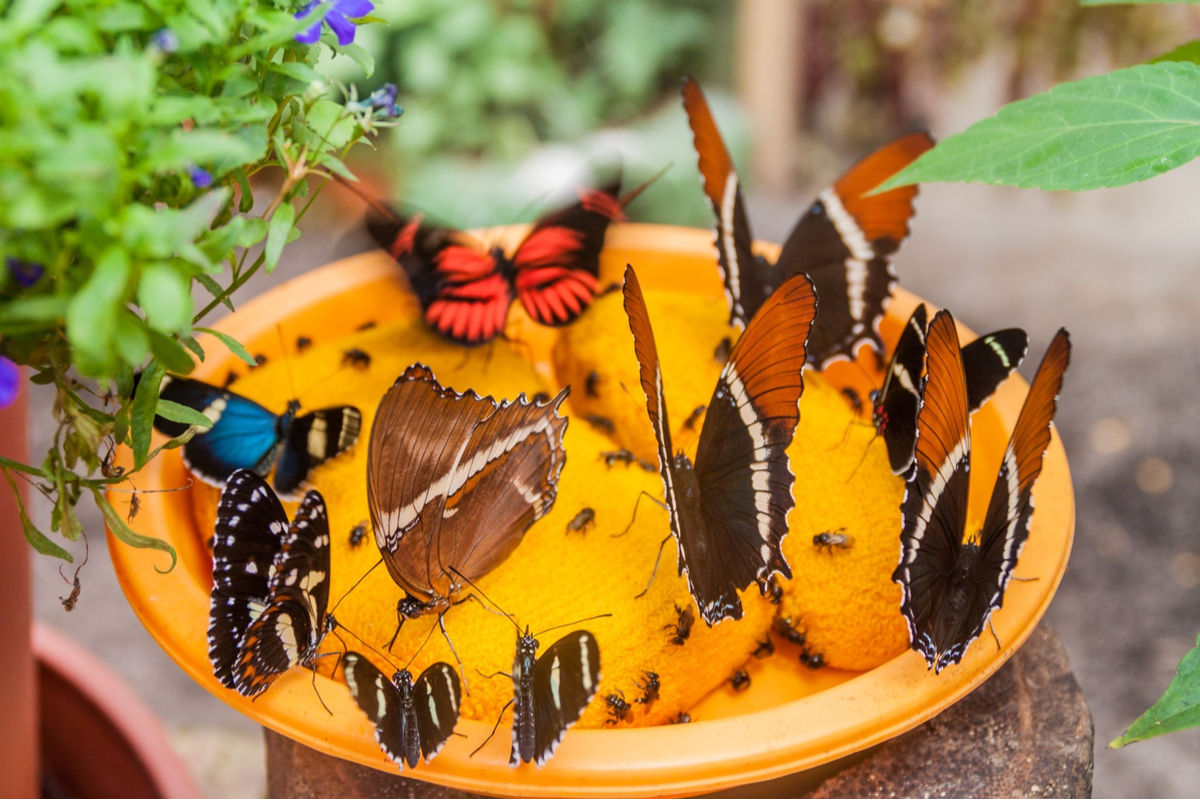By Jessica Jacobs, Contributing Writer
Butterflies are not only enchanting additions to any garden but also vital pollinators. If you’re looking to bring more of these beautiful insects into your outdoor space, creating a butterfly feeder is an excellent solution. These feeders offer butterflies a consistent nectar source, while also adding charm to your garden. Here are seven simple yet creative DIY butterfly feeder ideas to help you attract these graceful creatures.
1. Fruit Slice Feeder
Create a feeder by hanging slices of ripe fruits such as oranges, strawberries, or bananas on twine or string in your garden.
Why It Works: Butterflies are drawn to the natural sugars found in ripe fruit, and the bright colors and sweet scent act as strong signals. This feeder is easy to assemble and refresh, making it perfect for beginners.
2. Mason Jar Nectar Feeder
Fill a mason jar with a sugar-water solution and place a sponge or cloth inside to act as a wick. Hang the jar using twine or wire.
Why It Works: The sponge provides a resting spot for butterflies, and the mason jar mimics the elevated position of natural nectar sources. It’s also easy to monitor and refill the nectar.
3. Plate and Wine Cork Feeder
Fill a small plate with a sugar-water solution and add wine cork slices for butterflies to perch on.
Why It Works: The cork slices provide a place for butterflies to rest while feeding, and the color contrast between the plate and nectar helps draw their attention. This unique design adds a fun touch to your garden.

4. Popsicle Stick Feeder
Glue popsicle sticks together to create a platform with spaces between. Hang the platform with string and place fruit slices or mashed bananas on top.
Why It Works: The gaps in the platform offer multiple perching options, while the variety of textures and fruit appeal to butterflies, making this a simple and enticing feeder.
5. Sponge and Saucer Feeder
Cut a kitchen sponge to size and place it in a shallow saucer filled with sugar water. Hang the saucer using string or wire.
Why It Works: The sponge acts as a stable surface for butterflies to land on and absorb nectar, while the shallow saucer provides ample feeding space, attracting more butterflies at once.
6. Flower Pot Feeder
Fill a small flower pot with artificial flowers that have nectar centers, and place it on a saucer filled with sugar water.
Why It Works: The artificial flowers mimic real nectar-rich blooms, luring butterflies with their realistic appearance. This stylish feeder is perfect for those who want to combine functionality and decoration.
7. Orange Peel Cup Feeder
Halve an orange, remove the pulp, and fill the empty halves with sugar water. Hang the halves using string or wire.
Why It Works: The orange peel’s natural color and scent attract butterflies, while the cup shape offers a stable landing spot. This clever design repurposes fruit into an appealing feeder.
How to Attract Endless Butterflies
Attracting butterflies to your garden is not just about feeders but also creating the right environment. Here are key tips to keep butterflies coming back:
- Plant Butterfly-Friendly Flowers: Choose nectar-rich plants like milkweed, lavender, and zinnias to cater to various butterfly species.
- Provide Host Plants: Research native butterfly species and plant their preferred host plants for caterpillars. Monarchs, for example, need milkweed.
- Sunlit Spots: Butterflies rely on sunlight to regulate their body temperature, so ensure your garden has sunny areas for basking.
- Shelter: Plant trees, shrubs, and tall grasses to provide shelter from wind and predators.
- Avoid Pesticides: Pesticides can harm butterflies and their caterpillars. Use natural alternatives or encourage beneficial insects like ladybugs.
- Water Sources: Offer shallow dishes of water with sand or soil for butterflies to puddle, a behavior where they collect minerals.
- Create Colorful Blooms: Bright colors like red, orange, and purple attract butterflies. Group plants together to make them more noticeable.
- Plan for Continuous Blooms: Choose plants that bloom throughout the year to ensure a constant food source for butterflies.
- Organic Fertilizers: Avoid chemical fertilizers, which can harm butterflies and their host plants. Opt for organic or natural fertilizers.
- Windbreaks: Strong winds can make it difficult for butterflies to feed and fly. Use hedges or tall plants to protect your garden from gusts.
By implementing these strategies and incorporating DIY feeders into your garden, you can create an inviting environment that attracts and supports butterfly populations, transforming your garden into a vibrant, fluttering paradise.
